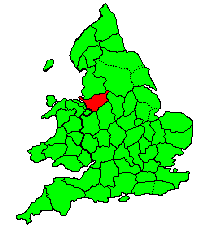 |
Cheshire, a palatine and maritime county of England, bounded on
the NW. by the Irish Sea, and bordering on the counties of Lancaster,
York, Derby, Stafford, Salop, Denbigh, and Flint; extreme length,
NE. and SW., 58 miles; extreme breadth, 40 miles; average breadth
18 miles; area, 657,123 acres; population 644,037. Cheshire forms,
towards the Irish Sea, a flat peninsula, the Wirrall [sic] (12 miles
by 7 miles), between the estuaries of the Mersey and the Dee, and
inland a vast plain separating the mountains of Wales from those
of Derbyshire. This plain is diversified with fine woods of oak,
and &c., and is studded with numerous small lakes or meres.
A low ridge of sandstone hills runs North from Congleton, near the
East border, and another extends from the neighbourhood of Malpas
to Frodsham, near the estuary of the Mersey. The chief rivers are
the Mersey with its affluent the Bollin, the Weaver, and the Dee.
The soil consists of marl, mixed with clay and sand, and is generally
fertile. There are numerous excellent dairy farms, on which the
celebrated Cheshire cheese is made; also extensive market gardens,
the produce of which is sent to Liverpool, Manchester, and the neighbouring
towns. Salt has been long worked; it is obtained from rock salt
and saline springs; the principal works are at Nantwich, Northwich,
and Winsford. Coal and ironstone are worked in the districts of
Macclesfield and Stockport. There are manufacturers of cotton, silk,
and ribbons, carried on chiefly in the towns of the East division;
and shipbuilding, on the Mersey. Cheshire contains 7 hundreds and
503 parishes, and is entirely within the Diocese of Chester.
(From Bartholemew's Gazetteer of the British Isles, 1887. -C.H.)
|

